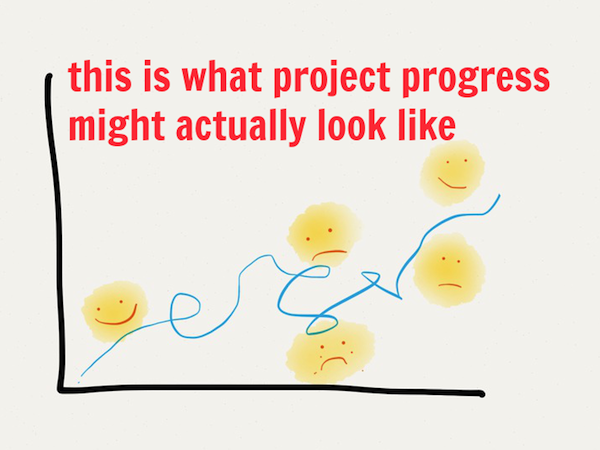Team aimlessness is a tricky foe. It creeps in even when we have the best intentions, corroding motivation and meaningful progress, rearing its ugly head in stalled projects, avoided emails, the checked-out employee.
In the world of software development, team aimlessness is public enemy number one. When it may take up to six months to a year to develop an idea into a usable application, it’s easy to lose sight of goals and your team loses steam.
If you have 83,000 lines of code, what does that mean? Where are you going? When coming into work starts to feel like Groundhog’s day, and focus dwindles, progress isn’t how many lines of code you’re writing.
Team Aimlessness Needs to Be Managed
There are so many forces that distract us from maintaining focus on a high-level mission. For one, we become consumed with reacting to situations and just getting stuff done to get through the day — losing sight of our larger purpose.
Team aimlessness needs to be managed. In our personal lives, we consistently procrastinate on personal goals because we fail to break them down into smaller components, protect ourselves from distraction, and hold ourselves accountable. Similarly, leaders often forget to steer the ship to the finish line, and the organization gets tossed around by the needs of the moment.
At Vonjour, we use a popular project management system called Agile Development to focus our team’s energy to achieve our objectives. Agile takes what seems like an insurmountable project and breaks it down into surmountable smaller tasks. Imagine you were told to build a three-mile bridge connecting Northern San Francisco to Marin County. What would you do? Probably run away. Instead, what if you were tasked with creating initial sketchings of the bridge? Seems much more manageable. Next, your job is to build a small prototype. Not too bad.
The smaller components are planned, or timeboxed, in two to four-week spans called “sprints” in which the team has just one goal: finish their task and deliver. The deadline acts as an enforcement mechanism that focuses the team.
To keep the team on track, team members have a daily “scrum” meeting in which the team leader (the “scrum master”) shepherds the group to help resolve roadblocks and coordinate the team. More generally, the scrum master shields the team from any distractions and facilitates progress. If someone from sales has a special feature request, the scrum master makes sure it doesn’t interfere with the current sprint and pushes it to the product planning session for another sprint.
While agile is commonly associated with technology development, its tenets can apply to just about any project or kind of work:
- Break projects into smaller tasks.
- Clearly define the success of the project.
- Team members must be accountable to deadlines.
- Project managers shepherd the team toward their goal.
- Sync regularly to stay on the same page and address problems quickly.
Sustaining Your Team’s Momentum
Even with regular sprint cycles and deadlines, long projects are fatiguing — especially when it seems like there is no end in sight. Building a project that may take 6 to 12 months to complete can seem like an eternity, and sustaining a team’s focus over long periods is hard. Focus is a finite resource that runs low especially when you think you aren’t getting anywhere. Over time, the regular cadence of the sprint cycle becomes gnawing if it just feels like “here we go again!”
At Vonjour, we were stuck building our core technology for months. We had pushed back our release dates multiple times. We forgot that our team was here to build out an application, not simply amazing scalable technology. After slogging through 7 months of technology development and losing steam, we finally gave ourselves a month to release our minimum viable product.
This key deadline was exactly what our team needed. We’d lost some direction, slipping on deadlines while new features kept creeping in. The new MVP deadline brought our goal back into view front and center. Every decision we made was determined by whether or not it would help us reach our goal, and every day we went harder and harder. We were locking in (think Morpheus in the Matrix becoming the One).
The final weekend before our release was tough but we could see the finish line. We were peaking at the right time. The high intensity of that final weekend not only resulted in more production, it also gave our team a sense of common purpose that would bind us well beyond our beta release. We hit our goal and within twenty minutes of our release we had our first user.
If you’re running the 1600 meters at the Olympics, you wouldn’t want to sprint straight out of the gates because you’d run out of gas fast. Instead, you put yourself in position to win by staying with the pack through a steady and methodical pace. When you finally hit that final lap, you hit the accelerator.
The same is true with product development and project management. The beginning of the project runs at a methodical, steady pace that puts you in position to succeed towards the end of the sprint — so you’re doing things like organizing processes, coordinating teamwork, and building out infrastructure. But you don’t want to stall in this mode.
To sustain focus, it’s critical to pace yourself. Guide your team’s energy toward a series of peaks. Build on prior successes and momentum. Make it a priority to constantly gauge your teams focus, while also defining short term and long term mission.
* * * * *
As with all aspects of life, purpose is the most important currency of your business. It is up to leaders to deliberately instill a sense of purpose into an organization so that everyone on the team knows their role in reaching those objectives. One of the greatest challenges for leaders is to define and execute on objectives that lead to subsequent organizational growth. If as a leader, you are not creating hope and helping people see the way forward, chances are, no one else is either.
Liked this post? Subscribe to our free newsletter for more great content on productivity, management, and how to work better!



